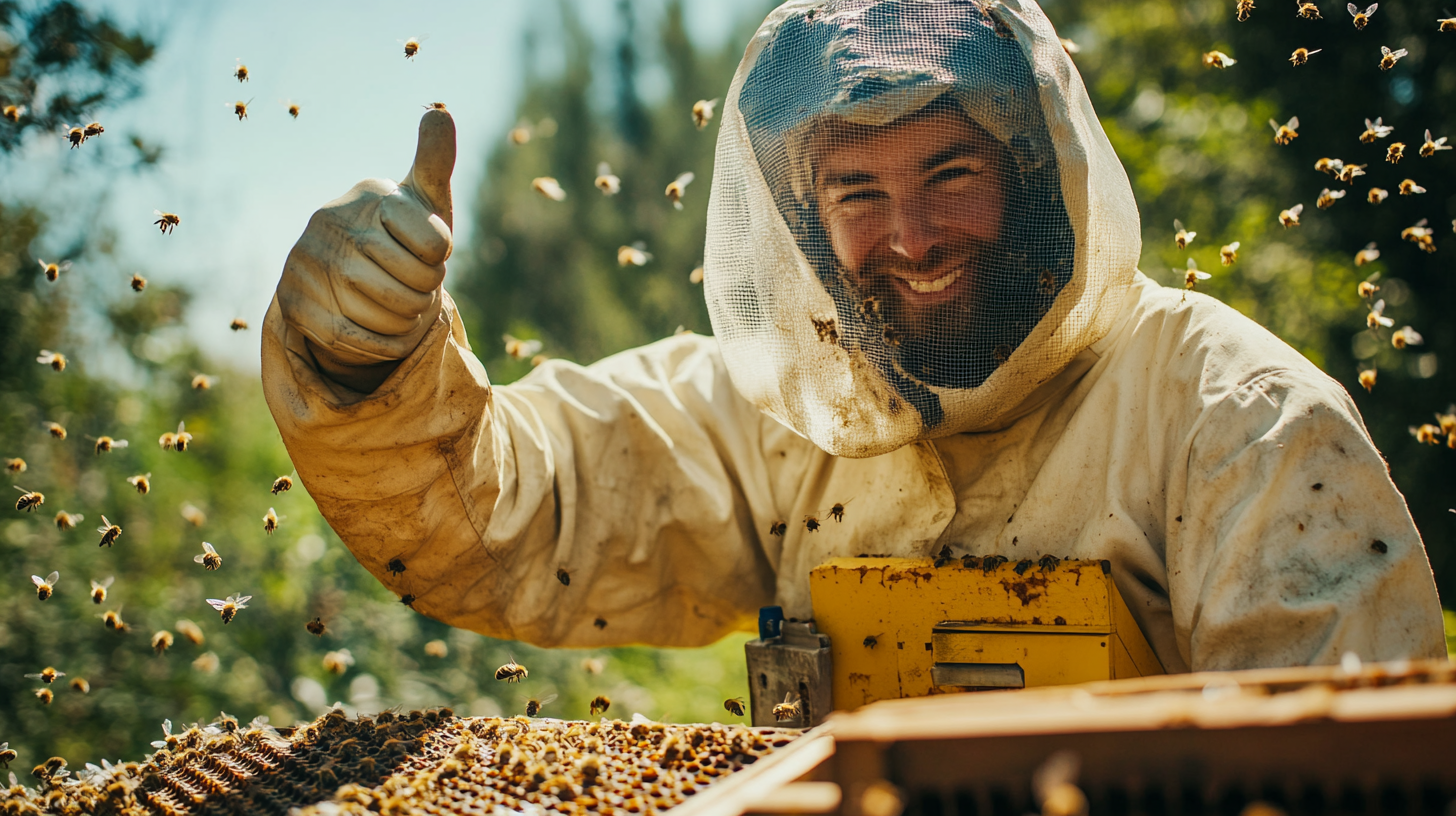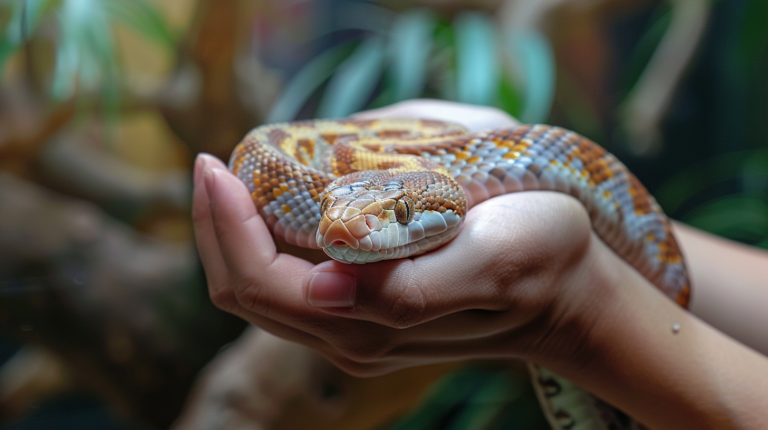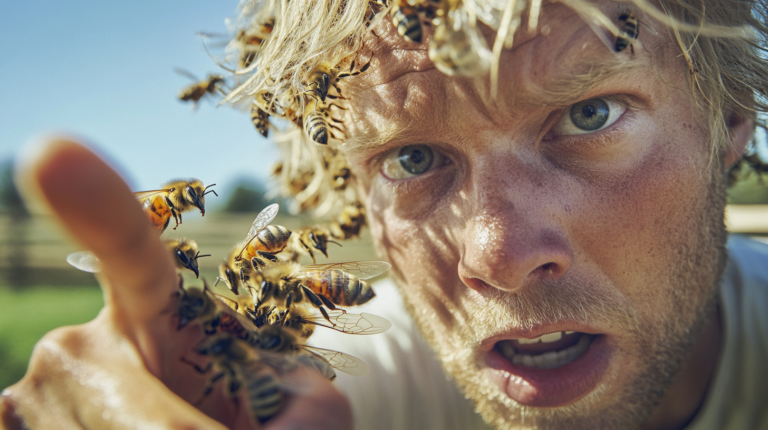Master your beekeeping schedule with our comprehensive seasonal beekeeping calendar. Discover 12 essential tasks to ensure healthy hives and maximum honey production year-round.
Table of Contents
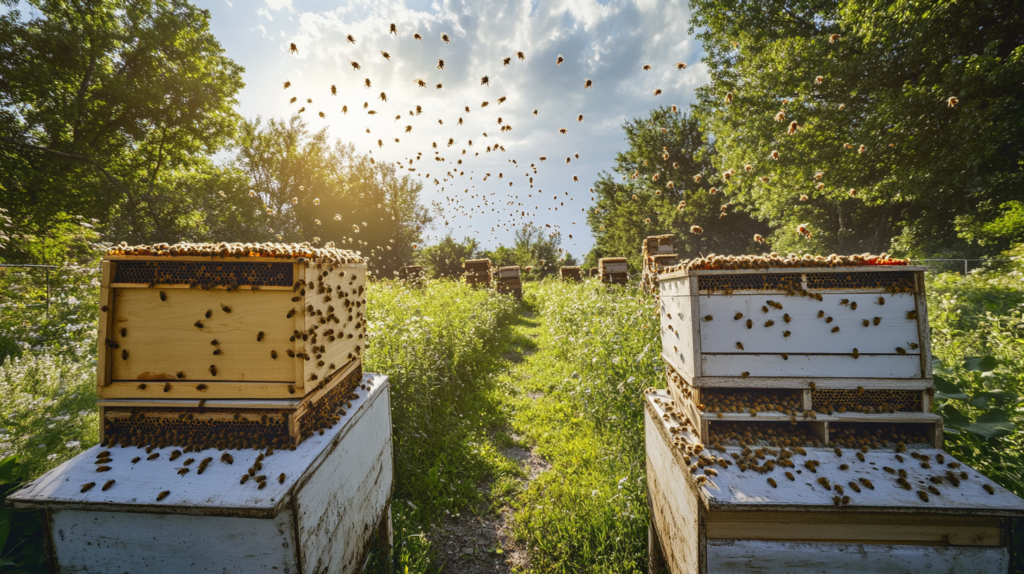
Successful beekeeping isn’t just about setting up a hive and hoping for the best—it requires careful planning and consistent attention throughout the year. A well-structured beekeeping schedule serves as your roadmap to maintaining healthy colonies, maximizing honey production, and ensuring your bees thrive through every season. Whether you’re a novice beekeeper or an experienced apiarist, following a systematic seasonal beekeeping calendar can mean the difference between a thriving apiary and struggling hives.
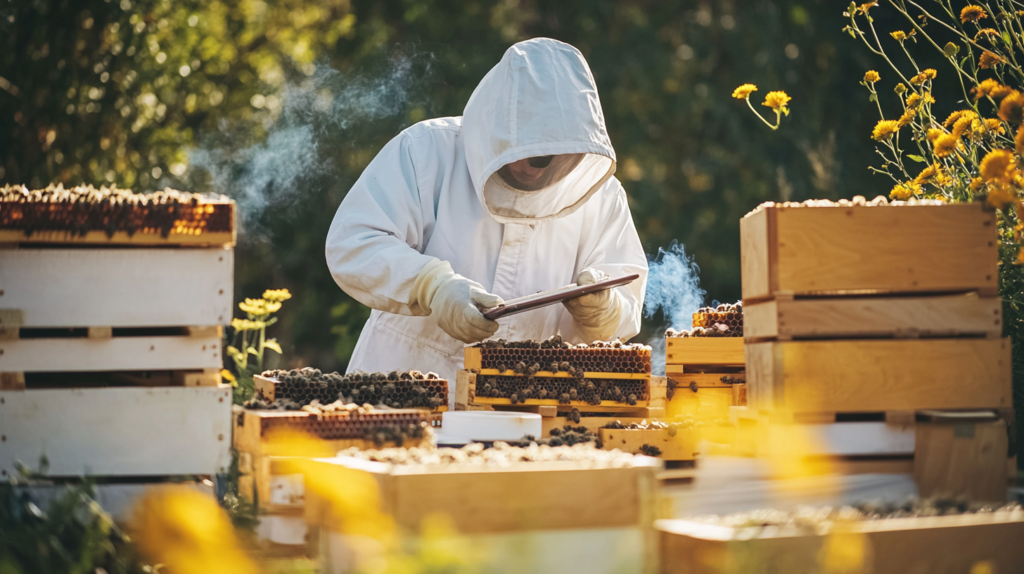
The art of beekeeping has evolved significantly over the centuries, but one principle remains constant: timing is everything. From spring inspections to winter preparations, each season brings unique challenges and opportunities that require specific attention. This comprehensive guide will walk you through 12 vital tasks that form the backbone of effective hive management, helping you develop a reliable routine that keeps your bees healthy and productive throughout the year.
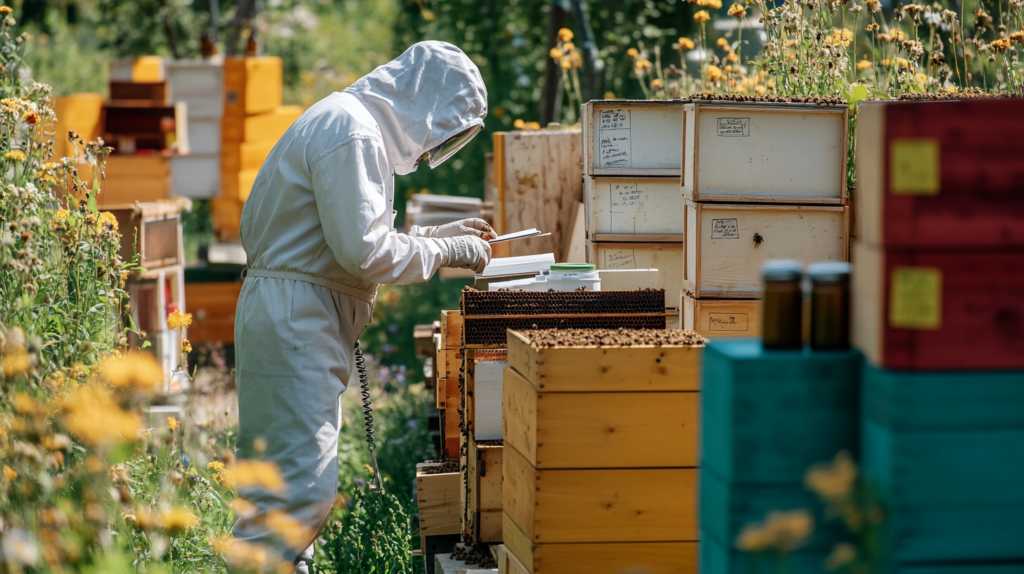
Understanding the Seasonal Beekeeping Calendar
Before diving into specific tasks, it’s crucial to understand how the beekeeping year flows. Unlike traditional farming, which follows a straightforward planting and harvesting cycle, beekeeping requires constant adaptation to seasonal changes, weather patterns, and colony dynamics. A successful beekeeping schedule takes into account regional climate variations, local flora blooming periods, and the natural lifecycle of honey bee colonies.
The beekeeping year typically begins in late winter when colonies start preparing for spring buildup. This preparation phase is critical because it sets the foundation for the entire year’s success. During this time, bee colonies begin increasing their population in anticipation of spring nectar flows, making it essential for beekeepers to ensure adequate food stores and healthy queen presence.
Regional Considerations for Your Beekeeping Schedule

Your location significantly impacts your seasonal beekeeping calendar. Northern regions experience longer winters and shorter active seasons, requiring different timing for inspections and treatments. Southern beekeepers may need to adjust their schedules to account for multiple nectar flows and extended active periods. Mediterranean climates present unique challenges with dry summers and mild winters, while mountainous regions require special consideration for altitude-related temperature variations.
Spring Tasks (March – May): Awakening the Hive
1. Early Spring Hive Inspection and Assessment
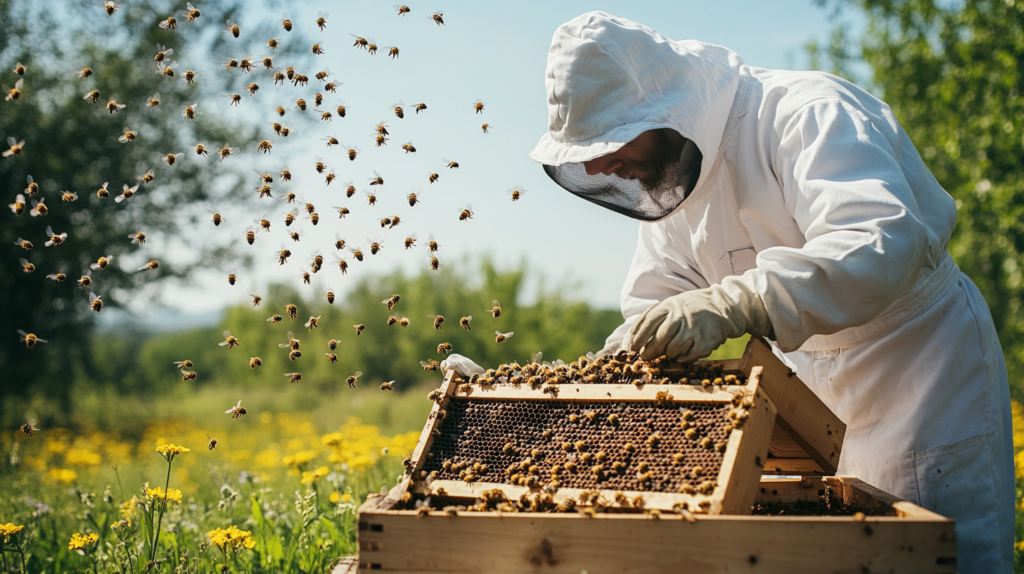
The first crucial task in your beekeeping schedule occurs during the early spring months when temperatures consistently reach 60°F (15°C) or higher. This initial inspection sets the tone for the entire year and helps identify any issues that may have developed during winter dormancy.
During your spring assessment, focus on these key areas:
- Queen presence and egg-laying patterns: Look for fresh eggs in worker cells, which indicate an active, healthy queen
- Population strength: Assess whether the colony has sufficient bees to support spring buildup
- Food stores: Check honey and pollen reserves to ensure adequate nutrition during early season growth
- Disease and pest indicators: Examine for signs of varroa mites, nosema, or other common bee ailments
- Hive equipment condition: Inspect frames, foundation, and hive bodies for damage or wear
According to the National Honey Board, colonies that receive proper spring management show 40% higher honey production rates compared to neglected hives. This statistic underscores the importance of thorough spring inspections in your seasonal beekeeping calendar.
2. Spring Feeding and Nutrition Management
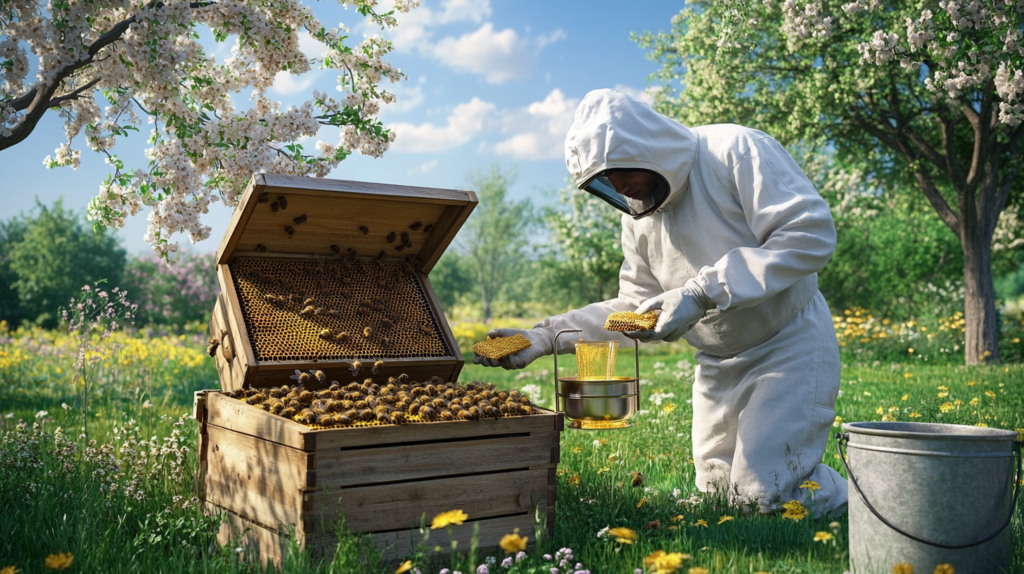
Proper nutrition during spring buildup is essential for colony success. Even if your hives survived winter with adequate stores, the rapid population growth during spring can quickly deplete food reserves. Implement a feeding program that includes:
Sugar Syrup Feeding Protocol:
- Mix 1:1 sugar-to-water ratio for early spring feeding
- Provide 1-2 liters per week depending on colony strength
- Monitor consumption rates to avoid overfeeding
- Discontinue feeding before honey supers are added
Pollen Substitutes and Supplements:
- Provide pollen patties when natural pollen sources are scarce
- Position patties close to the brood area for easy access
- Replace moldy or unused patties every 2-3 weeks
3. Equipment Preparation and Hive Expansion
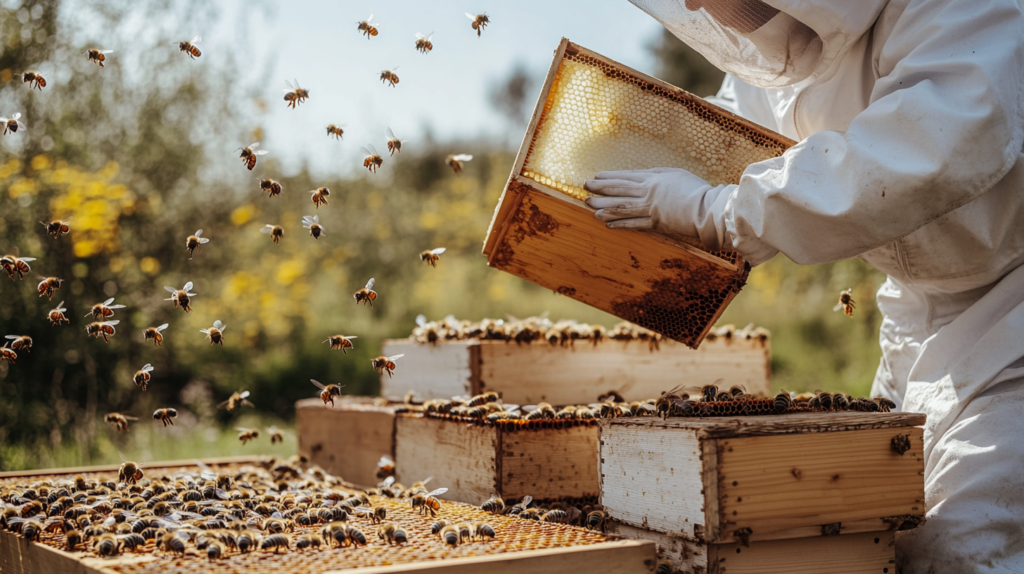
Spring is the ideal time to prepare additional equipment for the growing season. Clean and inspect all hive components, including:
- Supers for honey storage
- Frames and foundation
- Queen excluders
- Entrance reducers and ventilation equipment
As colonies expand, add supers before the existing space becomes 80% full. This proactive approach prevents overcrowding and reduces swarming tendencies.
Summer Tasks (June – August): Peak Season Management
4. Honey Flow Monitoring and Super Management
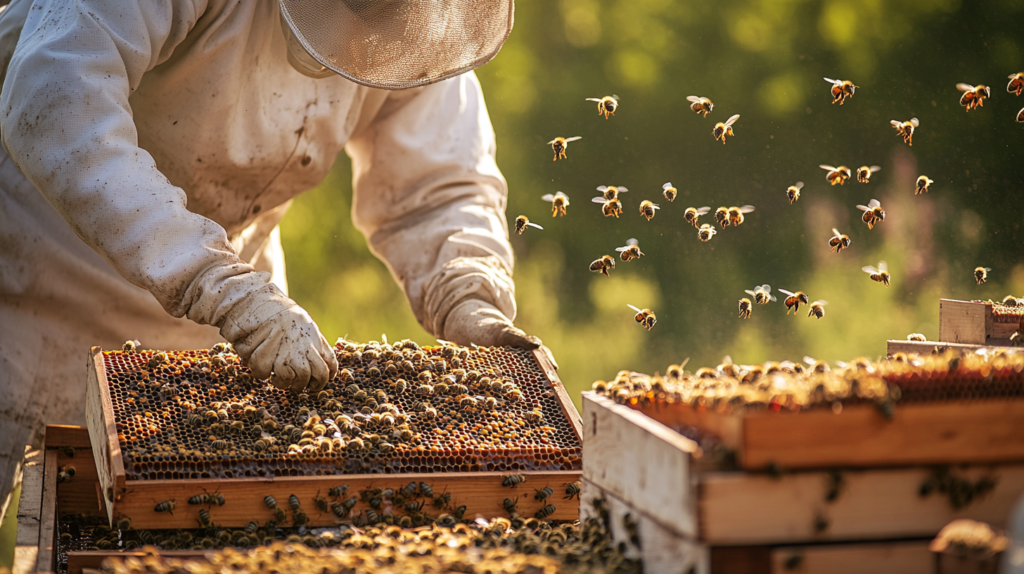
Summer represents the peak of your beekeeping schedule, when most honey production occurs. Successful summer management requires constant attention to nectar flows and hive capacity.
Honey Flow Indicators:
- Increased hive activity and foraging behavior
- White wax cappings on honey cells
- Rapid filling of honey supers
- Strong, sweet aroma from the hive entrance
Super Management Best Practices:
- Add supers when existing ones are 70-80% full
- Use queen excluders to prevent brood in honey supers
- Consider removing partially filled supers before main nectar flows end
- Rotate supers to encourage even filling
5. Swarm Prevention and Management
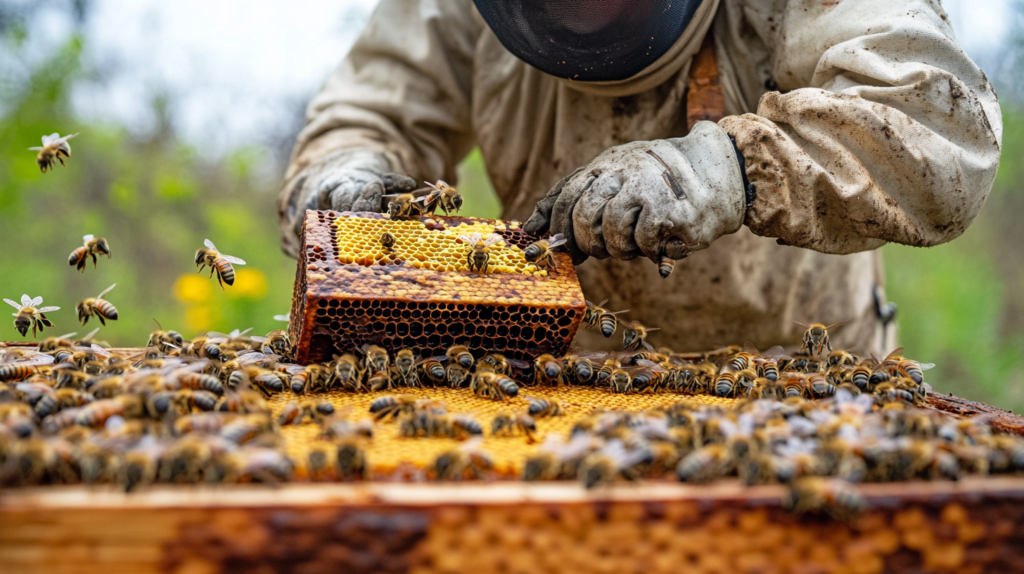
Swarming is the natural method of colony reproduction, but it significantly reduces honey production and can result in lost colonies. Implement these swarm prevention strategies:
Primary Swarm Prevention Methods:
- Provide adequate space through timely super addition
- Ensure proper ventilation during hot weather
- Remove or relocate queen cells during peak swarm season
- Consider splitting strong colonies to create new hives
Signs of Swarming Preparation:
- Multiple queen cells in various stages of development
- Reduced egg-laying by the queen
- Increased scout bee activity
- Clustering of bees outside the hive entrance
6. Varroa Mite Monitoring and Treatment
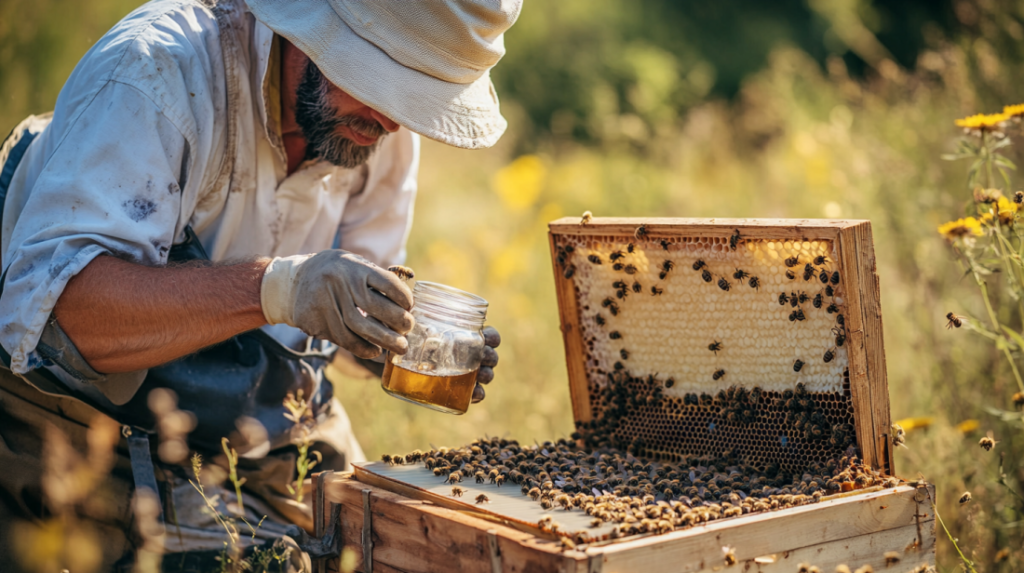
Summer monitoring for varroa mites is crucial because these parasites can quickly overwhelm colonies during periods of high brood production. Implement regular monitoring protocols:
Monitoring Methods:
- Alcohol wash or sugar roll sampling
- Sticky board counts
- Drone brood examination
- Natural mite fall assessment
Treatment Thresholds:
- 2-3% infestation rate during summer months
- Higher thresholds acceptable in fall before winter preparation
- Adjust treatment timing based on local conditions and mite pressure
Fall Tasks (September – November): Preparation and Harvest
7. Honey Harvest and Processing
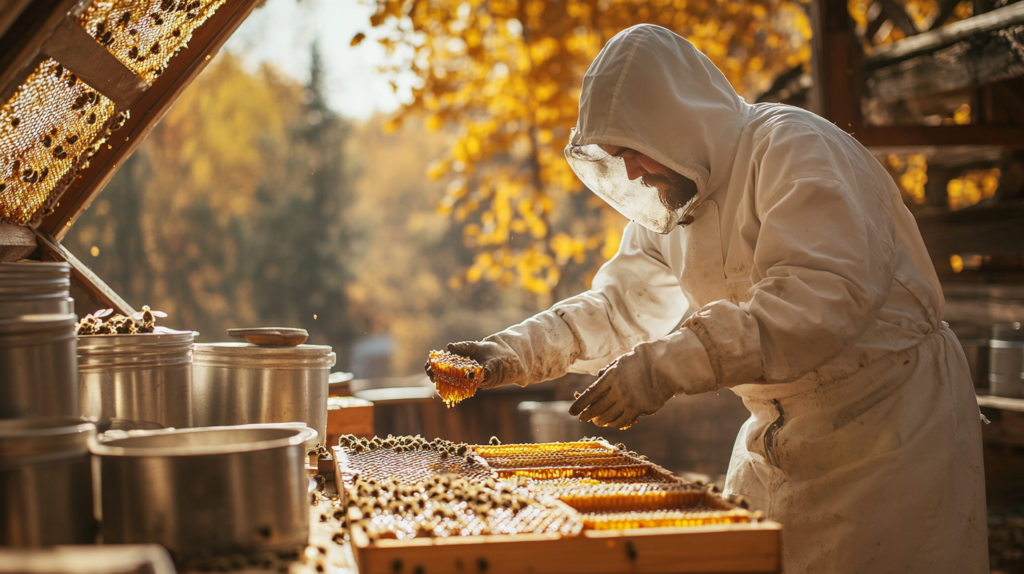
Fall marks the culmination of your seasonal beekeeping calendar efforts with honey harvest. Proper timing and technique ensure maximum quality and yield.
Harvest Timing Considerations:
- Wait until honey moisture content drops below 18.5%
- Harvest before late-season nectar sources cease
- Consider local regulations regarding honey labeling and sales
- Process honey quickly to prevent fermentation
Processing Best Practices:
- Use clean, food-grade equipment
- Strain honey to remove wax particles and debris
- Store in appropriate containers with proper labeling
- Maintain detailed records for inventory and sales
8. Fall Feeding and Winter Preparation
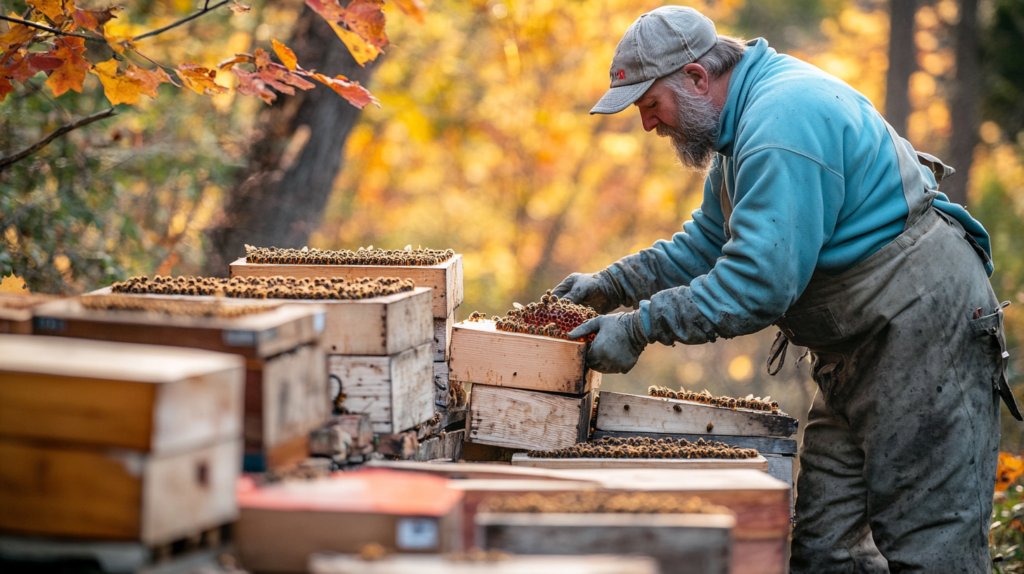
Colonies require adequate food stores to survive winter months. Fall feeding is often necessary to ensure survival, especially in regions with harsh winters.
Winter Food Requirements:
- 40-60 pounds of honey for northern climates
- 30-40 pounds for moderate climates
- 20-30 pounds for southern regions
Feeding Strategies:
- Use 2:1 sugar syrup for rapid consumption
- Provide feeding continuously until storage goals are met
- Consider fondant or dry sugar for emergency winter feeding
- Ensure adequate pollen stores for early spring brood rearing
9. Varroa Mite Treatment and Disease Prevention
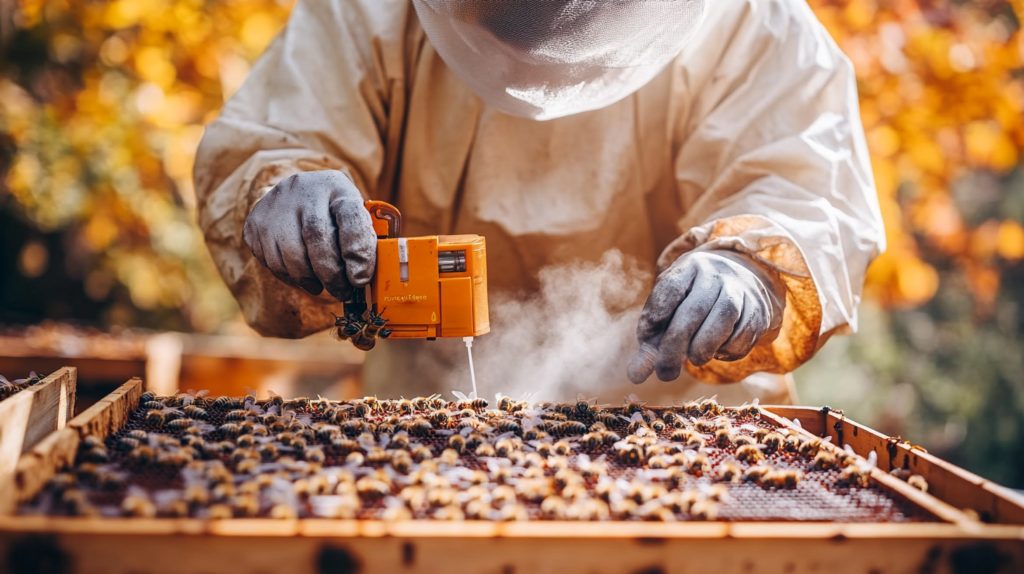
Fall represents the final opportunity to treat varroa mites before winter cluster formation. Effective treatment during this period is critical for colony survival.
Fall Treatment Options:
- Formic acid treatments during warm weather
- Oxalic acid treatments after brood cessation
- Integrated pest management approaches
- Monitor treatment effectiveness through post-treatment sampling
Winter Tasks (December – February): Maintenance and Planning
10. Winter Hive Monitoring and Maintenance
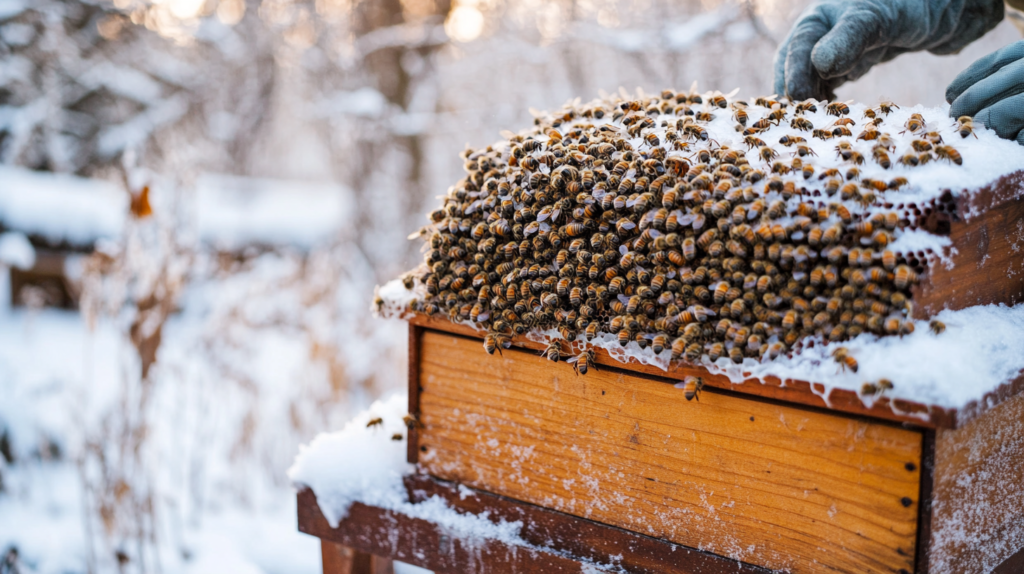
Winter hive management requires a delicate balance between necessary monitoring and minimal disturbance. Your beekeeping schedule should include periodic external assessments without opening hives.
Winter Monitoring Checklist:
- Check for adequate ventilation and moisture control
- Ensure entrance accessibility after snow or ice storms
- Monitor for signs of mouse intrusion or other pests
- Assess food consumption through hive weight changes
Emergency Interventions:
- Provide emergency feeding if stores are depleted
- Clear blocked entrances after severe weather
- Repair damaged equipment that could affect colony survival
11. Equipment Maintenance and Inventory
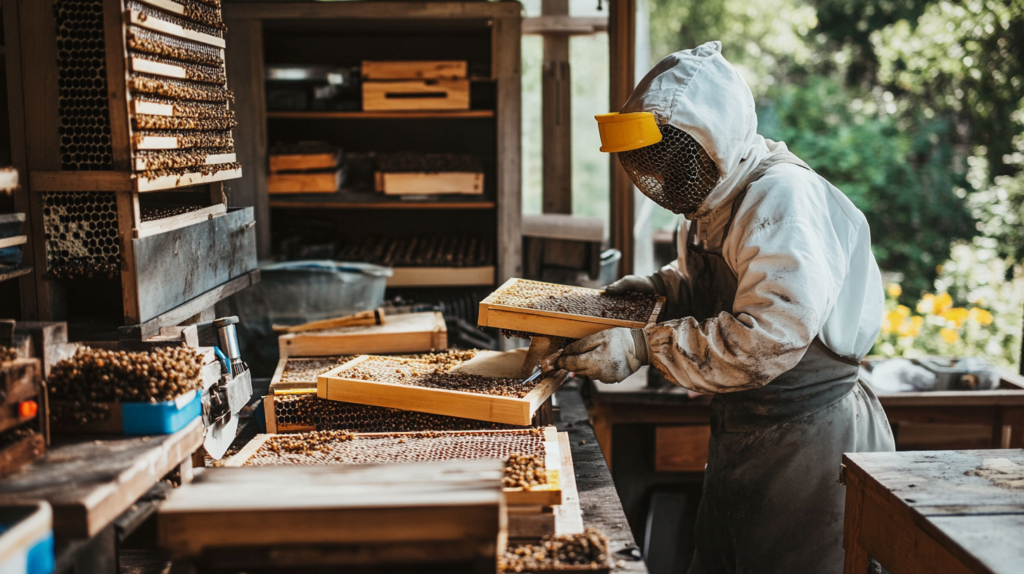
Winter provides opportunity for equipment maintenance and inventory preparation for the following season.
Maintenance Tasks:
- Clean and repair hive bodies and frames
- Replace worn or damaged equipment
- Inventory supplies and order materials for spring
- Prepare new equipment for colony expansion
Record Keeping and Planning:
- Review previous year’s hive records
- Plan for colony expansion or reduction
- Research new techniques and equipment
- Prepare budget for upcoming season expenses
12. Education and Skill Development
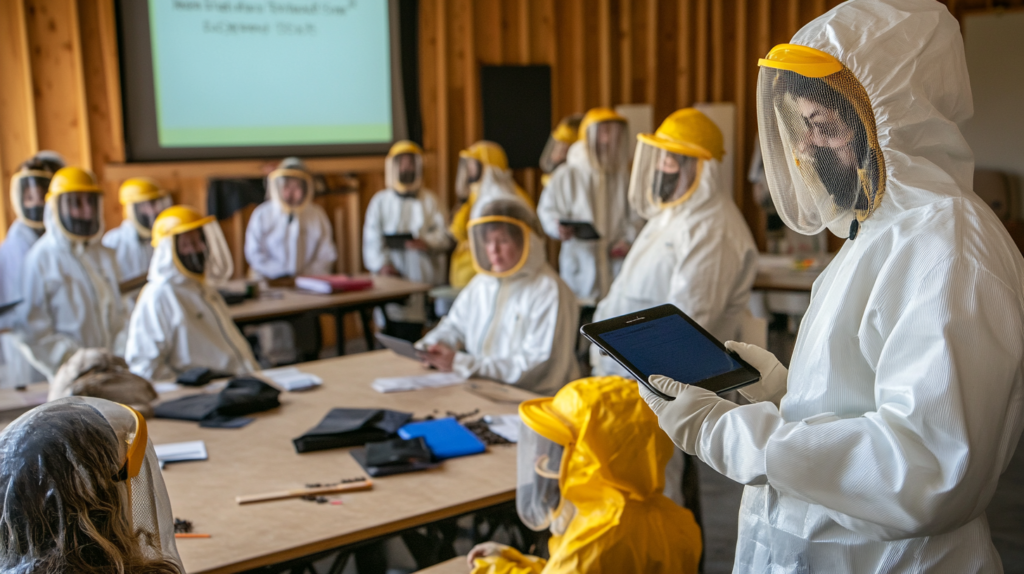
Winter months offer excellent opportunities for continuing education and skill development in beekeeping practices.
Learning Opportunities:
- Attend local beekeeping association meetings
- Participate in online courses and webinars
- Read current research and industry publications
- Network with other beekeepers for knowledge sharing
Creating Your Customized Beekeeping Schedule
Every apiary is unique, requiring customization of the basic seasonal beekeeping calendar to match local conditions, climate patterns, and personal management style. Consider these factors when developing your personalized schedule:
Climate Considerations:
- First and last frost dates in your region
- Average temperature patterns throughout the year
- Precipitation patterns and seasonal variations
- Local nectar flow timing and duration
Local Flora and Nectar Sources:
- Identify primary nectar sources in your area
- Map blooming periods for different plant species
- Understand seasonal nectar availability
- Plan management activities around major flows
Personal Factors:
- Available time for hive management
- Experience level and comfort with different tasks
- Number of hives in your operation
- Goals for honey production or colony expansion
Common Mistakes in Beekeeping Schedule Management
Even experienced beekeepers can fall into common traps that compromise their seasonal beekeeping calendar effectiveness. Avoid these frequent mistakes:
Timing Errors:
- Opening hives too early in spring
- Delaying fall preparations until too late
- Missing critical treatment windows for pest management
- Harvesting honey before proper ripening
Equipment Issues:
- Insufficient equipment preparation for peak seasons
- Failing to replace worn or damaged components
- Inadequate food storage for winter months
- Poor ventilation management during extreme weather
Management Oversights:
- Inconsistent monitoring and record keeping
- Ignoring early warning signs of problems
- Failing to adapt schedule to local conditions
- Neglecting continuing education and skill development
Advanced Scheduling Techniques for Experienced Beekeepers
As you gain experience with basic beekeeping schedule management, consider implementing these advanced techniques:
Integrated Pest Management (IPM):
- Coordinate treatment timing with brood cycles
- Use multiple treatment methods for maximum effectiveness
- Monitor resistance development in pest populations
- Adjust treatment schedules based on ongoing research
Queen Management Programs:
- Schedule queen replacement on regular rotation
- Coordinate queen introduction with seasonal timing
- Maintain queen-rearing schedules for consistent supply
- Implement genetic improvement programs
Production Optimization:
- Adjust colony strength for specific nectar flows
- Coordinate equipment placement for maximum efficiency
- Implement strategic feeding for production enhancement
- Monitor and adjust for changing environmental conditions
Technology and Tools for Schedule Management
Modern beekeeping benefits from various technological tools that can enhance your seasonal beekeeping calendar effectiveness:
Digital Record Keeping:
- Hive management software and mobile apps
- Digital photography for visual record keeping
- GPS tracking for multiple apiary locations
- Weather monitoring and forecasting tools
Monitoring Equipment:
- Electronic hive scales for remote monitoring
- Temperature and humidity sensors
- Entrance activity counters
- Remote camera systems for observation
Communication and Learning:
- Online beekeeping communities and forums
- Video conferencing for remote consultations
- Webinar platforms for continuing education
- Social media groups for real-time problem solving
For more expert pet care tips and product recommendations, visit BlithePet.com — your trusted source for pet wellness.
Frequently Asked Questions
Q: How often should I inspect my hives according to my beekeeping schedule? A: Inspection frequency varies by season and colony condition. During active season (spring through fall), inspect every 2-3 weeks. In winter, limit inspections to external observations only, checking monthly for signs of activity and access issues. New beekeepers should inspect more frequently initially to develop observation skills.
Q: When is the best time to start a new beekeeping schedule? A: The ideal time to begin beekeeping is early spring when package bees or nucleus colonies are available. This timing allows new colonies to establish themselves before winter. However, you can start planning your beekeeping schedule any time of year, using winter months for education and equipment preparation.
Q: How do I adjust my seasonal beekeeping calendar for different climates? A: Adapt your schedule based on local climate patterns. Northern regions require longer winter preparations and shorter active seasons. Southern areas may have multiple nectar flows and extended active periods. Consult local beekeeping associations and experienced beekeepers for region-specific timing recommendations.
Q: What happens if I miss a critical task in my beekeeping schedule? A: Missing scheduled tasks can impact colony health and productivity. If you miss spring feeding, colonies may not build up adequately for honey production. Delayed fall treatments can result in high mite loads and winter losses. Always prioritize critical tasks and seek guidance from experienced beekeepers when schedule disruptions occur.
Q: How do I balance work and family commitments with my beekeeping schedule? A: Successful beekeeping requires time management and flexibility. Plan major tasks during weekends or available time slots. Some tasks can be combined or adjusted within reasonable timeframes. Consider partnering with other beekeepers to share responsibilities and knowledge.
Q: Should I follow the same beekeeping schedule for all my hives? A: While basic seasonal timing remains consistent, individual hives may require schedule adjustments based on colony strength, queen performance, and local conditions. Strong colonies may need earlier super addition, while weak colonies might require extended feeding periods. Customize your approach based on each hive’s specific needs.
Conclusion
A well-planned beekeeping schedule forms the foundation of successful apiary management, ensuring your colonies remain healthy and productive throughout the year. By following these 12 vital tasks and adapting them to your local conditions, you’ll develop the skills and knowledge necessary for long-term beekeeping success.
Remember that beekeeping is both an art and a science, requiring constant learning and adaptation. Your seasonal beekeeping calendar will evolve as you gain experience and as environmental conditions change. Stay connected with local beekeeping communities, continue your education, and always prioritize the health and welfare of your colonies.
The rewards of following a disciplined beekeeping schedule extend far beyond honey production. You’ll contribute to pollinator conservation, develop a deeper understanding of natural systems, and enjoy the satisfaction of working with one of nature’s most remarkable creatures.
Have a similar experience with your beekeeping journey? Share your seasonal management tips and challenges in the comments below!

